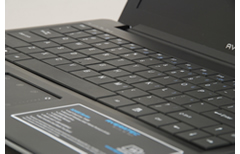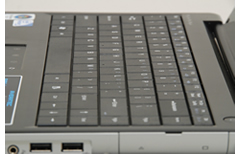Averatec N3400 Inside and Out
Inside the box we found the notebook, an external optical drive unit that connects via USB and comes standard as part of the bundle, a suede carrying pouch, quick start guide, power cord and AC adapter. Instead of a printed user manual, Averatec included a digital copy on the desktop in PDF format.
Because we received the N3400 weeks before the Windows 7 launch, our review sample shipped with Vista Home Premium 64-bit. A quick check at some of the online retailers offering this unit shows it is eligible for a free Windows 7 upgrade now that it has become available.

The first thing you'll notice about the N3400 is its slim profile and aluminum external shell. At its thickest point, the notebook remains under the 1" mark measuring just .98 inches. The front of the notebook has no buttons or switches to clutter the bezel, while the right side features SPDIF compatible headphone and mic jacks, as well as two USB 2.0 ports, a Kensington lock slot, and a cover that hides the network and VGA-out ports.



The back of the system is totally plain with no connectors in sight. Moving to the left side we find the power connector, fan exhaust vents, a third USB 2.0 port and a 4-in-1 card reader (Secure Digital, Memory Stick, Memory Stick PRO, Multi Media Card).

On the bottom there are four cooling vents as well as two circular openings for the integrated speakers. The N3400 uses an internal battery instead of using the traditional lock latch found on most laptops. You may also have noticed there is no quick access the hard drive bay and memory slots.
To access the internals you must first remove the four rubber feet – I had to use the tip of a knife to pry them out. Under each foot is a single screw. Remove all four and the bottom panel slides off. This design helps Averatec achieve a clean look for the N3400, and also explains why they include an extra set of rubber feet as part of the package.

Inside the laptop we find two memory slots, both of which are populated, as well as the hard drive and battery. The battery is held in place by four tiny screws, so I assume it could be replaced a few years down the road when it loses its capacity to hold a sufficient charge.

Opening the lid we find a very slim but sturdy glossy display. The inner bezel of the screen and keyboard are black – I half expected the aluminum from the outside to carry over but no such luck. The minimalist approach is applied here as well. Aside from the power button, there are no additional buttons for hotkeys. Instead, Averatec has integrated these features into the touchpad ("Dual Pad").

The touchpad operates normally until you tap the top right corner and switches the device into 'Icon mode'. From here, you can tap any of the seven icons on the outskirts of the touchpad to activate the corresponding program. These include a Windows Media Player key, Internet Key, Email key, Volume key and three programmable hotkeys. The touchpad also features a multi-gesture system that allows you to pinch, flick and swirl your fingers in various programs to flip through pictures, scroll through web pages and many other tasks.

The touchpad itself is big enough but I am not a fan of the buttons used. I prefer a two-button system instead of the solid, single large button Averatec used. I also found it difficult to locate the mouse click button without looking, as there isn't much distinction between the button and the bezel surrounding it. Perhaps an inset button or more pronounced button of some sort would have worked better.


The keyboard is full sized and uses flat top keys. The keys have a nice feel to them but if you haven't typed on flat keys before, it may take some time getting used to. Each row of keys is slightly inset as you pull your fingers from the top row down towards the bottom. This helps to keep you from slipping down to the next row accidentally as you type. It somewhat reminded me of stadium seating at the movie theater.
My only complaint with the keyboard layout is the placement of the Function key, in the bottom left corner where the Control key should be.